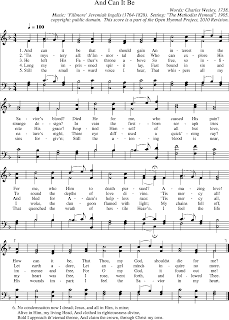Hymn Title: Come Thou Long Expected Jesus
Tune: Hyfrydol
Numeric Outline: 87.87.87.87
This hymn is traditionally an advent hymn being sung to ask Jesus to hurry up and get here. The advent season is all about waiting to see the long expected arrival of the Messiah, Jesus Christ. The author of the text is none other than Charles Wesley, of whom I had written about in an earlier blog (see And Can It Be). Published in the 1744 Hymns for the Nativity of our Lord, the text has two stanzas, the first of which explains the anticipation for the arrival of Jesus created by the prophecies that will be fulfilled. The second stanza regards the excitement and amazement that followed the actual birth of Jesus. It says he was only born a baby, but he is still a King. As is typical with Charles Wesley's hymns, the text displays two messages at once: Christ is coming to fulfill the prophecies of old, and Christ will return again one day as is promised in the scripture.
The tune Hyfrydol was first published in 1830 by Rowland H. Prichard. He was a welsh composer born in 1811 just outside of Bala, North Wales (Graenyn, North Wales to be exact), where he lived for most of his life serving as a loom tender's assistant in Holywell, North Wales where he eventually would pass away in 1887. It wasn't until 1844 that Prichard published his only known work Cyfaill Y Cantorion (The Singer's Friend). His most famous tune was Hyfrydol, which is most commonly used with "Come, Thou Long Expected Jesus," which the best known arrangement came from none other than English Composer Ralph Vaughn Williams. Vaughn Williams was known for his adaptations on several original hymn tunes, creating new arrangements for wind bands and for bras bands all across England.
The Text:
(1) Come, Thou long expected Jesus
Born to set Thy people free;
From our fears and sins release us,
Let us find our rest in Thee.
Israel’s Strength and Consolation,
Hope of all the earth Thou art;
Dear Desire of every nation,
Joy of every longing heart.
(2) Born Thy people to deliver,
Born a child and yet a King,
Born to reign in us forever,
Now Thy gracious kingdom bring.
By Thine own eternal Spirit
Rule in all our hearts alone;
By Thine all sufficient merit,
Raise us to Thy glorious throne.
The Hymn:
My take on the Hymn:
The first verse is a statement of how excited the world is to see Jesus come to us as promised. The verse praises Jesus for the things that he hasn't done yet, but is prophesied to do. The text calls Jesus our strength, our hope, and our dear desire, which is only a small way of explaining how we really feel about Jesus and his birth. The second verse is all about what happens when Jesus finally does arrive into the world. The verse is broken up into two parts: praise for Christ being born, and a prayer for Christ to be born into our hearts. The new born baby who was given to the world in a lowly manger was a King. This is one of the greatest things that God could have given the world, not just because our savior was born, but because he was born in the most humble of places, a manger. The second half talks about Jesus coming into our hearts to show us that all we need is Christ, and we will eventually rise to be upon a glorious throne in Heaven.
Lets talk for a second about what God could have meant by bringing Jesus to us in a manger. I see two particular meanings in this, the first being God wanted to show us that Jesus came to be with the common people and the people who were not righteous and holy, but the people who needed to be saved, which leads into the second meaning, mangers are dirty places, filled with animals and with hay for the animals, as well as waste from the animals. This is one of the greatest symbols that God gave us in the bible (may I stress the emphasis of one, not the, greatest symbols). To understand the symbolism of this, we must look at why God gave us Jesus. Jesus was given to the world because the world was full of sin and needed to be saved. Jesus being born in a manger was summing up the actual task of Jesus in a small form.





